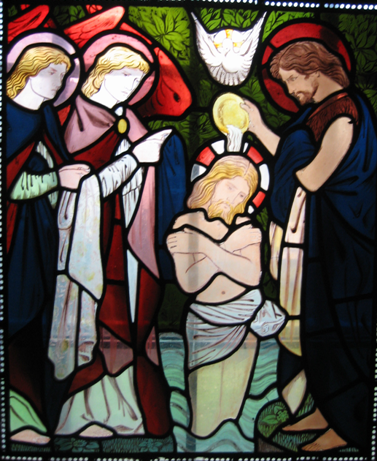Background
Designed for Christ Church, Bishopwearmouth by William Morris & Co 1856
Rededicated in Sunderland Minster 2003
Mr W. T Bell decided to gift the East window to Christ Church, Ryhope Road, Sunderland in memory of his uncle W. Bell Esq. Under the direction of the architect, Mr E. R. Robson, Messrs Morris, Marshall, Faulknar & Co of London were commissioned to supply the window. This company was made up of a collection of brilliant but unconventional men who came together under the direction of William Morris and designed furniture, wallpaper and glass.
William Morris was born in 1834 at Walthamstow, his father being a wealthy stockbroker. The family soon moved to Woodford Hall where William spent his childhood. He read widely and took an interest in the arts, literature and nature: trees and flowers were a dominant theme of his early wallpaper designs.
At Marlborough College, rather against his family’s evangelical tradition William encountered the Tracterian Movement, a high church body and on leaving college he began to make plans to train for the ordained ministry. He soon joined a group of like-minded fellows, among them Edward Burne-Jones and, much to his family’s dismay, decided to become an architect.
Over the next few years Morris gathered around him a number of talented friends who together designed a wide range of furniture, decorations and household articles.
It was the making of stained glass that soon become the group’s specialism and in 1861 they formalised the association as Morris & Co with William Morris as director; the other members being Ford Madox-Brown, Philip Webb and Dante Gabriel Rosetti. Their style was to design a Biblical scene in a square panel of stained glass and then use these pictures in different combinations in various churches. Many of the panels therefore can be seen in other churches but the combination is unique.
Originally in Christ Church the ten scenes were arranged in two horizontal rows of five; they are now in three vertical groups.
From the top left moving downwards:-
- ¨ ‘The Nativity’ by Burne-Jones one of the most popular
- designs made by the company.
- ¨ ‘The Adoration of the Magi’ again by Burne-Jones and used first in 1864 in Amington, Staffs.
- ¨ ‘The Baptism of Christ’ also by Burne-Jones, used in St. Michael’s Brighton in 1862 and also at Gatcombe on the Isle of Wight.
- From the top centre moving downwards:-
- ¨ ‘The Wedding Feast at Cana’ by William Morris and first used in 1861 at Cranbourne near Windsor.
- ¨ ‘The Sermon on the Mount’ by Rosetti which, in Selsley, is the central section of a bigger three-light window.
- ¨ ‘The Miracle of the Loaves and Fishes’ by Morris thought to have been used for the first time in this window but later also in Meole Brace near Shrewsbury.
- ¨ ‘Christ’s Blessing of the Children’ by Madox-Brown and first used in Cranbourne.
- The panels on the right hand side are all by William Morris.
- ¨ ‘The Last Supper’ at the top was first used at Gatcombe.
- ¨ ‘The Marys at the Empty Tomb’ used at St Michael’s, Brighton
- ¨ ‘The Ascension’ first used in the Chapel of St Edmund Hall, Oxford.
The top central Agnus Dei (Lamb holding a flag) is the work of Philip Webb and is found in most of the company’s windows.
The roundels of angels are only two included from eight in the original Christ Church window, a constriction of the different shape of the two pieces of architecture.
The distinctive lightness of the colour used by Morris and his friends contrasts starkly with contemporary Victorian glass with its darker deeper colours.
So at the beginning of 2003 it was possible to install and rededicate in Sunderland Minster a wonderful example of the work of a group of brilliant men who changed the course of art and design in this country.

